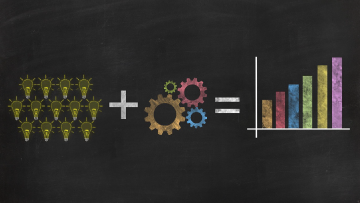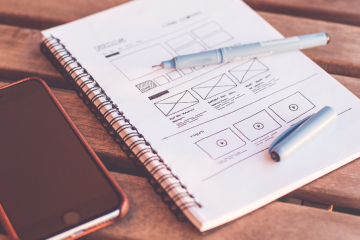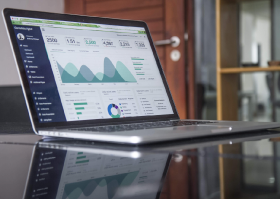Tips for a Successful Website Redesign
At some point, every website owner will eventually contemplate whether or not they need to upgrade, overhaul, update, rebuild, or makeover their existing site, otherwise known as a website redesign.
While a website redesign can be a fun and exciting project, it can also include a number of variables that range greatly in scope depending on your needs. Before you run out and start designing the next iteration of your website, below are some tips to help you think through some of the key considerations that will help make your redesign project a success.

Redesign or Rebuild?
One of the first important decisions you'll need to make is to define the scope of your redesign project. Many people use the terms "redesign" and "rebuild" interchangeably for web projects, but they each have different meanings and hold significant differences for your project requirements. One of the first things you'll want to do is assess whether you need a redesign or a complete rebuild.
- Redesign - If you are relatively happy with your site's content management capabilities and features, and if your current setup will likely meet your needs for the foreseeable future, then you are a good candidate for a redesign. You have a good foundation to build on, so your back-end setup will remain largely the same, and you will focus on front-end updates, which could range from minor tweaks to a full scale design overhaul. In addition to your aesthetics, you may want to refine your site's content structure, page layout, and/or add new features that can be accommodated within your site's existing platform.
- Rebuild - In some cases, you may need more than a pretty face to bring your website up to speed. If your website does not allow you to efficiently manage site content, or if it is incompatible with certain features or functionality that you require, now is a good time to consider a complete rebuild along with your redesign efforts. In short, you will want to update both the front-end and the back-end of your website.
What are Your Goals?
It seems simple, but this often-overlooked question is a key component for the initial planning and discovery process for a website redesign. Many organizations simply decide that the look and feel of their website had become "stale" after a few years, and decide they want to "freshen" things up because it seems like that's what everyone else is doing. But for optimal results, you'll want to drill down a few levels deeper to make sure you're going to get meaningful results and maximum value on your investment in a redesign project. After all, you're probably not going to do this very often, so you want to get it right.
When considering the goals for your website redesign, it can be helpful to start with high-level guiding questions such as:
- What are the particular problems or issues that we are trying to solve with this project?
- How have our needs changed since the last time we updated the website?
- What are the specific outcomes that we want to achieve with this redesign, and how can we measure them?
Let the answers to these questions help guide your project goals and requirements.
Look Through Varied Lenses
For optimal results, a redesign project should be viewed from different angles in order to make sure that you taking a well-rounded approach that will produce results and meet both your immediate and long-term needs:
User Experience
Are you relatively happy with your existing site structure and page layout, or do you want to change the way
that people navigate the site and/or interact with different page elements? Knowing how you want your
redesign to impact user experience is really the foundation of your redesign. Sitemaps and wireframes are
effective tools to help you define any structural changes that impact user experience, and help to inform
the new design.


Functionality
Are there specific things you would like your site to do that it doesn't currently do? If so, you will
want to identify all of your functional requirements so that they can be factored into the project scope,
and also reflected in your new design concepts wherever applicable.
Conversion Goals
Most website owners have specific actions they want users to take on their website, whether it's to make
an inquiry, or a purchase, a donation, or a download - typically you want your visitors to take one or more
measurable actions, and those are called conversion goals. How well is your website currently performing for conversions, and how can the new website
design take this into account? A strategic design can help drive visitors to your desired conversion goals
in a way that will have real-world results for your bottom line.


Brand Identity
Your website is a formal representation of your organization's brand. Are you happy with your brand
identity - have you been contemplating a change to your logo or collateral materials? If so, you will want
to address these issues BEFORE starting your web project. It is not uncommon for organizations to pursue a
website redesign to address brand identity issues, and while there is indeed overlap, these are two separate
things. Ideally, you want to make sure your brand identity is well-established beforehand so that it can
inform your website design, as well as other marketing materials that you may produce for consistency across
all your organization's media.
Content and Messaging
Sometimes a website redesign project is only about appearances, but often it is also an opportunity to
revisit your site's content and tone. Does your content still effectively speak to your target
audiences, or does it need to be updated? Perhaps you have new ideas for content topics that do not exist on
your current website. Having a plan for your content should be addressed in the early stages of your
redesign project planning, because if it is left as an afterthought it can hold up the deployment process
once everything else is complete.


Design
Last but not least are the aesthetic design considerations for your redesign project. If you've done
your homework, all of the above factors - from user experience, to functionality, conversions, brand
identity, content and messaging - will collectively inform your design process and help shape the finished
results. Of course, you will also need to think about the overall look and feel that you want to convey with
your site - are you looking for a new design that is radically different from your current site, or perhaps
you want to maintain much of what you have and just make it a little more contemporary. Providing examples
of other sites that you like (with as much details as possible about what you like specifically) will be
incredibly helpful to your designer as he or she drafts concepts for your website's new design scheme.
Bear in mind that these items are all interrelated variables, so changes in one area will typically impact another. For example, the decision to add a new content section will require updating your navigation scheme to accommodate it; the development of a new feature may require the page layout to change in a way that allows that feature to be integrated into the site design. It's important to take all of these considerations into account and figure out where they may overlap as your design plan takes shape.

Take Stock of Your Digital Assets
Most websites integrate a range of digital media assets such as photography, brand graphics, video, virtual tours, data charts, and downloads. You will want to assess whether you will be migrating assets from your existing site, or whether you will also need to acquire new assets to work with your updated design scheme. Even if you want to utilize existing photography, consider that if your page layout is changing you may very well need to resize many of your images to meet new size specifications.
If you are planning to have new photos or graphics on your website it is also important that you have a plan for acquiring them. If you need to hire a photographer, purchase stock photography, or develop new custom illustrations, you will want to make sure that you factor these items into your budget and timelines.
Oftentimes, it's helpful to begin your project with a media audit and review the findings with your designer in order to confirm what is available and what is needed, so that you can plan appropriately.

Let the Data Talk to You
Many websites have powerful analytics tools running behind the scenes (e.g. Google Analytics), but the data that they collect is often overlooked when making important decisions about your website. Planning a website redesign is a great opportunity to let your website analytics tell you something about what your website visitors find the most and least interesting on your website (the results may surprise you), and what drives conversions. This information can help inform smart decisions about your site's design and content structure.
For example, if you find that you have a lot of mobile visitors coming to a specific conversion page on your website, you may want to take extra care in your design plan to make sure that you include some calls-to-action that really stand out on mobile touchscreen devices.
While analytics data is subject to interpretation, it is also an objective source of information that can be incredibly helpful to educate your team about how your website is used, and help to inform your project planning. If you do not already have a good handle on your web analytics, a good first step in your redesign pre-planning is to conduct an analytics assessment to uncover any notable user trends. Best of all, this will also help you establish a baseline against which you can compare future performance once your website redesign is complete. Wouldn't it be nice to measure your return on investment?
In Conclusion
It's easy to jump into the fun aspects of design, brainstorm ideas, hunt for examples of websites you like, and contemplate how awesome your new site is going to look once it's finished. But if you take a little time to dig beneath the surface, you will be far more likely to end up with a site that is not only better-looking, but one that will actually meet your long-term needs, facilitate your goals, and produce measurable results. It's well-worth the extra effort.
Does Your Website Need a Redesign?
If you're contemplating a makeover or redesign for your organization's website feel free to reach out - we'll be happy to answer any questions you may have and provide tips and recommendations for your own redesign project. Whether you just need a few simple tweaks, or a full scale overhaul from the ground-up, we can help you make smart decisions for a successful project.
To learn more, simply complete the form below and we’ll be happy to follow-up with additional information, including:
- Needs Assessment
- Cost Estimates
- Questions & Answers

